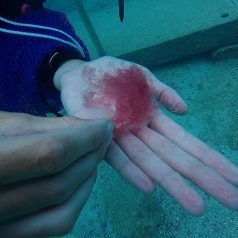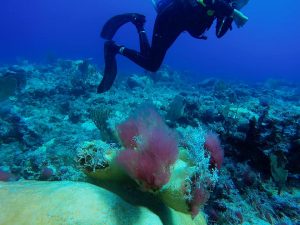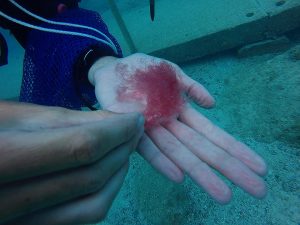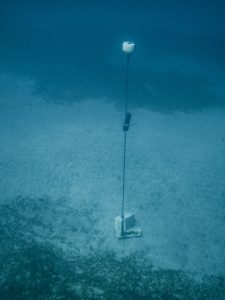
Just over two months ago, the Caribbean was hit by hurricane Irma, one of the most intense hurricanes ever to be recorded. The windward Dutch Caribbean islands (Saba, St. Maarten, and St. Eustatius) were all in the path of the hurricane, with St. Maarten right in its eye. The hurricane caused severe devastation on all three islands, but fortunately, the damage was quickly restored on Saba and St. Eustatius. St. Maarten, however, suffered a lot more damage to both its infrastructure and nature. And only days later, the island was hit again, this time by hurricane Maria, which caused strong winds as it passed off the northern side of the island. Now, in the wake of the hurricanes, their direct and indirect effects are becoming increasingly clear.
In an interview with the Dutch newspaper NRC, the manager of the Sint Maarten Nature Foundation and Save Our Sharks project leader, Tadzio Bervoets, spoke about a natural disaster for the island. An estimated 750.000 liters of fuel leaked (and continue to leak) into Simpson Bay as the hurricane caused approximately 300 boats to sink in Simpson Bay and Oyster Pond. Also, an estimated 80% of the existing mangroves around the island were uprooted or destroyed. The national icon the of the island, the brown pelican, went from 60 breeding pairs to only 15 or 20 after the hurricanes passed. Adding to the list of damages: the shark tracking research carried out by the Nature Foundation, as well as dive moorings and other scientific experiments are no longer existent. Speaking to the Members of Parliament of St. Maarten, Bervoets stated that the region should expect more similar-sized hurricanes in the future as a result of man-induced climate change.
So how bad is the environmental damage caused by the hurricanes? First of all, coral reefs, mangrove forests, seagrass beds and other coastal ecosystems were already threatened by anthropogenic threats such as pollution and coastal development. Unfortunately, the hurricanes delivered an extra hard hit on these, already vulnerable, ecosystems.
Although the majority of fuel leaking from the sunken vessels in Mullet Bay and Oyster Pond is floating on the seawater, wave action and tidal currents will cause the fuel to mix with the seawater or sink over time. Thus causing nearby coral reefs and other marine life to be exposed to the toxins. In addition, the outflow of wastewater from boats is worrisome. The increased input of nutrients into the coral reef ecosystem can make unwanted algae grow rapidly and cover the reefs. The Nature Foundation, during their damage assessment, found blooms of red algae on the St. Maarten reefs, which can hamper the regrowth of several reef species that were damaged due to hurricane Irma’s swells. Red algae are strong competitors and their fast growth rate will leave no space for important reef builders such as corals and sponges to recover. The state of the coral reefs is especially worrisome as 50% of the reef was found to be damaged by Hurricane Irma.
Further pollution caused by the hurricane, like plastic materials, can cause an indirect threat to sharks and other marine life.


Rode algenbloei vastgesteld op het rif in het Marine Park
Due to developments, an estimated 80% of the mangroves on St. Maarten were already removed. Of the 20% that remained on the Dutch side of the island, another 80% was uprooted and destructed by the two hurricanes. Mangroves are essential as a nursery for many young reef fish species, including juvenile lemon sharks. A decline in mangroves can also cause a decline in the survival of the early life stages of these fish, indirectly influencing fish abundance on nearby coral reefs. In addition, the seagrass and mangroves in the internationally recognized RAMSAR site Mullet Pond, are also directly under threat by pollution from debris.

St. Maarten’s diverse nature is an area of interest for many scientific studies. The Nature Foundation maintained a coral nursery project aiming to breed local coral species on underwater frames, before transplanting them back onto natural substrates thereby boosting coral reefs around the island. As part of the Save Our Sharks project, the Nature Foundation, in close cooperation with scientists from the Dutch institute Wageningen Marine Research, placed eight acoustic receivers around the Dutch side of the island. Several Caribbean reef sharks, nurse sharks, and tiger sharks were equipped with tags transmitting a high-frequency sound signal. The receivers, attached to the ocean floor on strategic locations around the island, continuously logged whether one of the tagged sharks would swim in its vicinity (< 800 meters). Unfortunately, the hurricanes swept away or buried the coral nursery structures, as well as all the acoustic receivers, which jeopardizes the future of both scientific studies. With the loss of the acoustic receivers, scientists lost at least a year of important data on shark distribution around the island, information that is essential for effective conservation of sharks in the region.

Due to the sheer strength of hurricane Irma, many hotels were destroyed or severely damaged, causing St. Maarten’s income from tourism to tumble. Thousands of tourists enjoy the beautiful reefs of St. Maarten every year, but with most dive moorings gone, boats can no longer visit the dive sites. The lack of this important source of income further delays the recovery of the island and its beautiful nature, both on land and underwater.
The staff of the Sint Maarten Nature Foundation works very hard to give nature a helping hand by cleaning up beaches, salvaging sunken vessels, controlling pollution, installing new dive moorings, and restarting scientific projects. To help the team and the sharks in the waters of St. Maarten, the Save Our Sharks team in the Netherlands initiated a crowdfunding campaign.
- Please consider making a donation to help nature and the sharks of St. Maarten!
- Please consider making a donation to help nature and the sharks of St. Maarten!
Text and photo acoustic receiver: Guido Leurs





